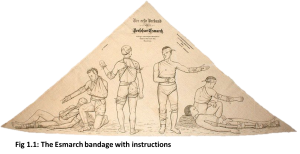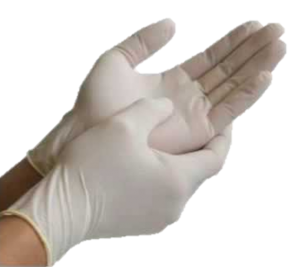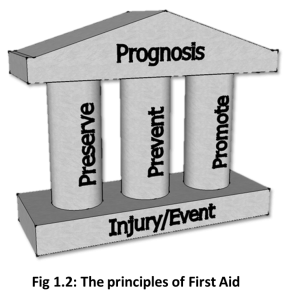A Brief History of First Aid
The Binding of wounds has been depicted in Greek pottery from 500 BCE and a system of First Aid was a dopted in ancient Rome. The term 'erste hilfe -First Aid" was coined in 1870 by the Prussian Military surgeon Friedrich van Esmarch, this led to the formations of various organisations aimed at standardising First Aid, both regionally and then later internationally. The same surgeon (van Esmarch) was credited as the inventor of, what we now call the 'triangular bandage', then it was known as the "The Esmarch bandage".
dopted in ancient Rome. The term 'erste hilfe -First Aid" was coined in 1870 by the Prussian Military surgeon Friedrich van Esmarch, this led to the formations of various organisations aimed at standardising First Aid, both regionally and then later internationally. The same surgeon (van Esmarch) was credited as the inventor of, what we now call the 'triangular bandage', then it was known as the "The Esmarch bandage".
First aid was born on the battle field but has a place in everyday life.
The Principles of First Aid
Through the years some methods, technologies and even terminologies have changed, but the same principles have been mooted as the aim of applying First Aid, namely;
- To Preserve Life
- To Prevent the injury/illness from becoming worse
- To Promote healing
The Fear of providing help
First aid is taught around the world but even though people hold a certified first aid certificate, many will not act when an emergency arises. The failure to act can be attributed to five common reasons, all these reasons may be overcome with the right knowledge and understanding of the emergency.
-
Danger – A scene of an emergency may seem to be too dangerous to attend and this is a legitimate problem as we never want to see a rescuer injured in the process of helping others, but with training, knowledge, and the ability to remain calm, most emergencies can be dealt with in a safe way. Other scenes may require that you stand back, call for help and wait for the professionals to arrive and take control of safety.

- Body fluids and the risk of contamination – During training you learn about universal precautions taken to protect yourself from contamination. With these precautions, emergency scene acquired infections are extremely rare.
- Unsure of your ability to help – Regular First Aid Training and practice will help to alleviate this fear.
- What if I make it worse? – Relying on your training it is uncommon to make the patients’ condition worse, that is, if you understand and stay within your ‘Scope of Practice’. In the case of a non-breathing patient requiring Cardio-Pulmonary-Resuscitation (CPR); this individual is clinically dead therefore we should put aside our fears of breaking ribs and such – You can’t make a dead person ‘Deader’.
-
 What if I get sued? – Unlike in North America where they have a law called the ‘good Samaritan act’, in South Africa we have no such formalised law. However, we have something that can protect the First Aider; Firstly, the courts are lenient to the fact that the first aider was trying to help and had no malicious intent to do harm. The courts will also adopt the ‘Reasonable Man Test’, where person with similar experience and training will provide testimony to the court and based on this, the court will determine culpability. As per our research; we could not find a case in South African law where the First Aider was brought before the courts to determine culpability.
What if I get sued? – Unlike in North America where they have a law called the ‘good Samaritan act’, in South Africa we have no such formalised law. However, we have something that can protect the First Aider; Firstly, the courts are lenient to the fact that the first aider was trying to help and had no malicious intent to do harm. The courts will also adopt the ‘Reasonable Man Test’, where person with similar experience and training will provide testimony to the court and based on this, the court will determine culpability. As per our research; we could not find a case in South African law where the First Aider was brought before the courts to determine culpability.
First Aid as a life skill
In the current landscape, First Aid training is mostly conducted as a regulatory requirement by labour and/or safety departments. In some cases, individuals, will learn some First Aid in clubs and organisations. There are many organisations that provide First Aid training, some are accredited whilst others provide unaccredited training. Either way first aid should be considered a life skill rather than a, regulatory requirement. The training provided to you by your company can also be used in your personal life and can result in you saving the life of your friends and family and indeed, the life of a stranger.
How many First Aiders/First aid kits are required in your workplace?
Any South African company that employs more than ten (10) employees, needs to have at least one (1) person that is a holder of a valid and accredited first aid certificatefor every fifty (50) employees, and in the case of a shop or office, the ratio is one (1) for every one hundred (100) employees.
If a company employs more than five (5) employees, the company must provide at least one (1) first aid kit at or near the workplace.
The number of kits required is determined by the employer, considering:
- The type of injuries likely to occur at the workplace.
- The nature of activities performed
- The number of employees in the workplace
Critical skills in First Aid
“Air goes in and out, blood goes around and around, any variation is a bad thing”, this may seem to be a very simplistic description of a patient’s condition, but it describes the critical skills required to save a life.
Air Goes in and out
-
Artificial respiration
- Mouth to mouth
- Rescue breaths
- CPR
-
Airway Management
- Head tilt, Chin lift
- Jaw Thrust Manoeuvre
- Recovery position
- Abdominal/Chest Thrusts
Blood goes around and around
- CPR
-
Bleeding control
- Direct pressure
- In-direct pressure
- Elevation
- Haemostatics (agents that shorten clotting time of blood; aiding bleeding control)
- Cooling
The passion for First Aid
At first Aid Priority, we have a passion for First Aid, we have seen first-hand, the effects that the critical skills have had on the prognosis of a patient in need.
As a paramedic led organisation we have been at emergency scenes and have witnessed First Aiders with little experience, but with adequate training, save lives by applying their training.
We have the knowledge, skills and experience to guide you into the discovery of the advantages of learning First Aid.
You may never need to use your first aid training, but if you do, it could mean the difference between life and death of a loved one.
What we provide.
-
Department of Labour accredited and unit standard aligned First Aid
- Level 1,2 & 3
- Basic First Aid
- CPR Courses
- Customised and specialist courses
- First Aid and Emergency equipment
